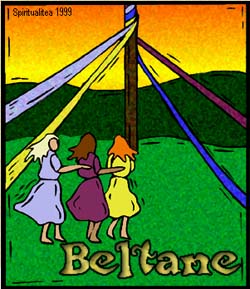- Halloween.
Sly does it. Tiptoe catspaws. Slide and creep.
But why? What for? How? Who? When! Where did it all begin?
‘You don’t know, do you?’ asks Carapace Clavicle Moundshroud climbing out
under the pile of leaves under the Halloween Tree. ‘You don’t REALLY know!’
–Ray Bradbury
from ‘The Halloween Tree’
Samhain. All Hallows.
All Hallow’s Eve. Hallow E’en. Halloween. The most magical night of the
year. Exactly opposite Beltane on the wheel of the year, Halloween is
Beltane’s dark twin. A night of glowing jack-o-lanterns, bobbing for
apples, tricks or treats, and dressing in costume. A night of ghost
stories and seances, tarot card readings and scrying with mirrors. A
night of power, when the veil that separates our world from the
Otherworld is at its thinnest. A ‘spirit night’, as they say in Wales.

 Now
Now